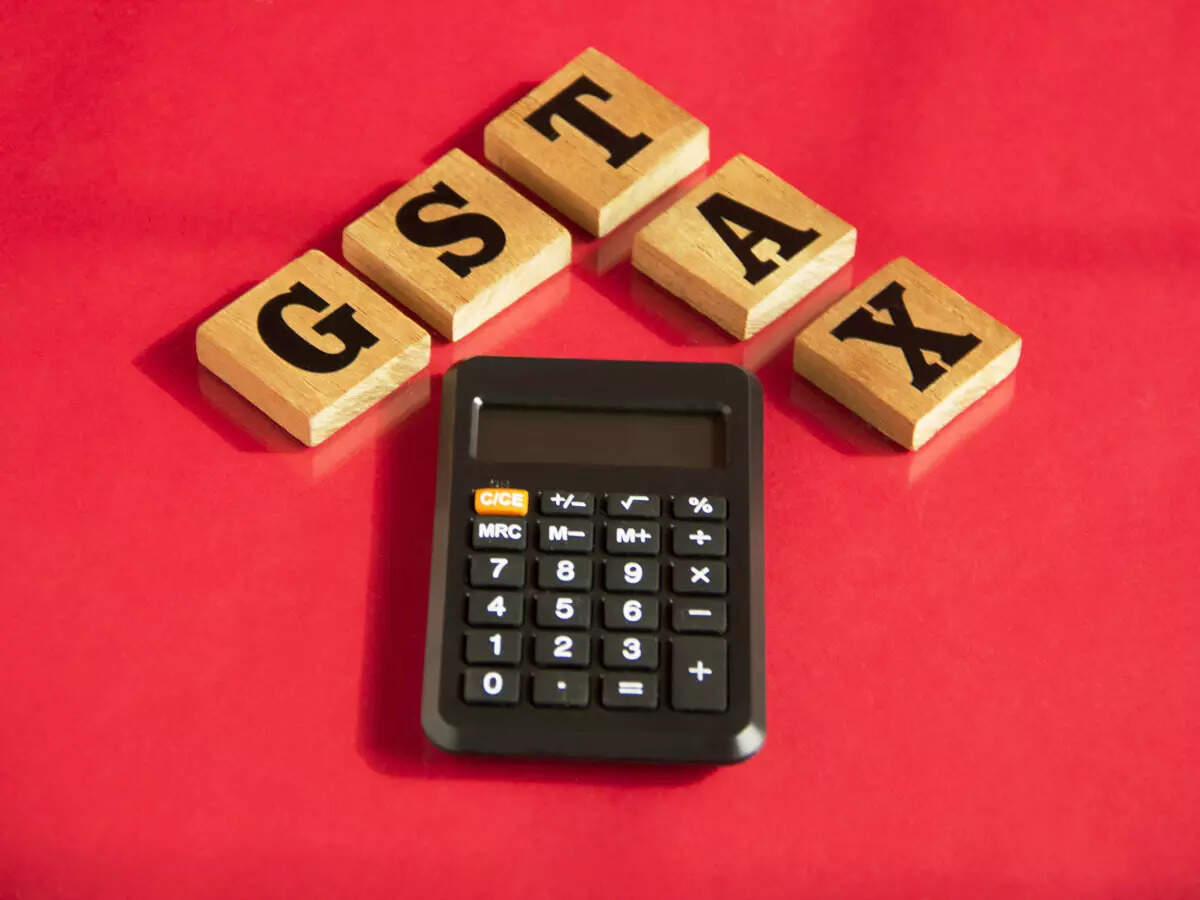
NEW DELHI: On July 1, 2017, the Centre had rolled out a major reform in the indirect taxation system in India in the form of goods and services tax (GST).
Five years later, the tax regime is said to have played a key role in defining India’s economic structure and empowering businesses by subsuming 17 taxes and 13 cesses into a ‘one nation, one tax’ structure.
Centre’s GST revenue collection is significantly high today, as compared to what it was initially. At Rs 1.44 lakh crore, the gross GST collection in June is the second-highest after April when it was about Rs 1.68 lakh crore.
This is the fifth time that the monthly GST collections crossed the Rs 1.40 lakh crore-mark since its inception and the fourth month at a stretch since March 2022.
Speaking at the GST Day celebrations on Friday, finance minister Nirmala Sitharaman said within 5 years of its implementation, GST is showing its potential and Rs 1.40 lakh crore is now the “rough bottom line” for monthly revenue collections.
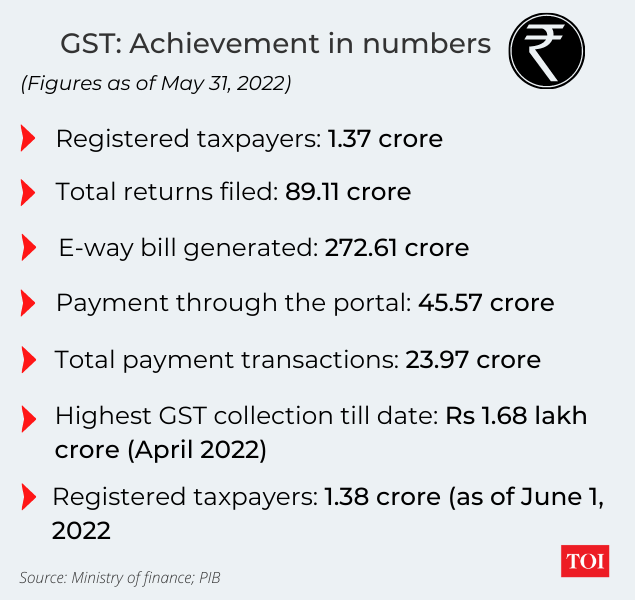
However, the structure faced many challenges in the last 5 years and is still evolving, trying to be more transparent and easy for taxpayers.
Even though the tax has brought about a paradigm shift in use of technology to ensure tax compliance, there have been many hits and misses in the last 5 years.
In other words, it is still a work in progress. There’s a long way to go to achieve the full potential of GST and make it a true ‘good and simple tax’.
Journey of implementing India’s biggest tax reform
The GST was first announced in the Union Budget 2006-07. Since then the Empowered Committee of Ministers worked on preparing the background material and the draft Acts.
Finally, the implementation materialised with the passing of the Constitutional Amendment Act in September 2016, followed by state legislatures. GST was then rolled out with effect from July 1, 2017.
The GST Council was constituted as a constitutional body for making recommendations to the Union and state governments. It has met 47 times till now.
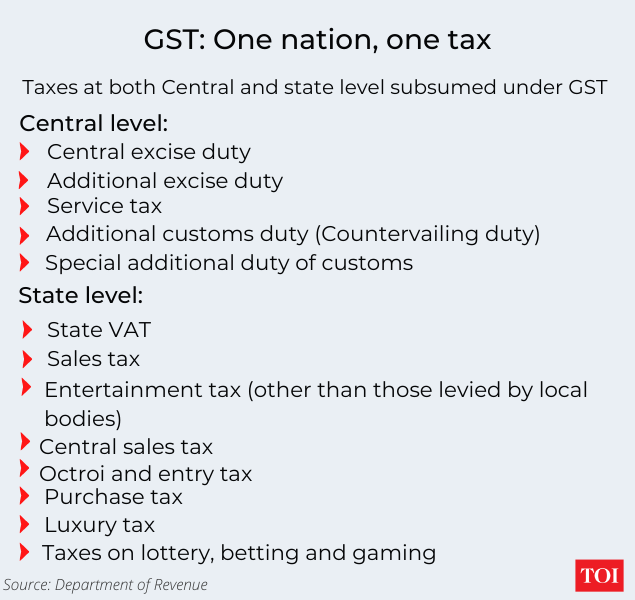
The then finance minister Arun Jaitley, who played a key role in introducing GST in India had stated that the new regime will prove to be both consumer and assessee friendly.
The finance ministry had claimed that every minute detail of every item sold will need to be digitally uploaded in a central tax database for all businesses.
In the pre-GST era, the Centre could tax goods up to the production or manufacturing stage, while states collected taxes on sale or distribution of goods. Services could be taxed only by Central government.
However, GST provided provision to both Centre and states to tax the entire supply chain in goods as well as services, from production to distribution. A centralised system for filing returns and uploading invoices also meant reduction in tax evasion.
Even though this eliminated the need for businesses to remember, keep track and pay for each separate taxes, the regime had its own challenges for taxpayers.
The website of GST crashed multiple times, making it difficult for taxpayers to file returns on time. In addition, the complex structure of compliances made it even more challenging for business owners.
Small businesses and the micro, small and medium enterprises (MSME) suffered the most as transitioning to the new system proved to be an expensive affair. From adoption of computer systems for filing returns, to hiring a Chartered Accountant (CA) to understand the procedure involved and file returns, which led to a surge in expenses.
Over the past years the government has been proactively issuing circulars and clarifications to clear doubts regarding taxation under GST and ensure ease of doing business. The Centre has achieved its objective of one nation, one tax to a large extent.
More recently, the GST Council, in its 47th meeting in Chandigarh, decided to ease compliance for small taxpayers who supply through the e-commerce platform.
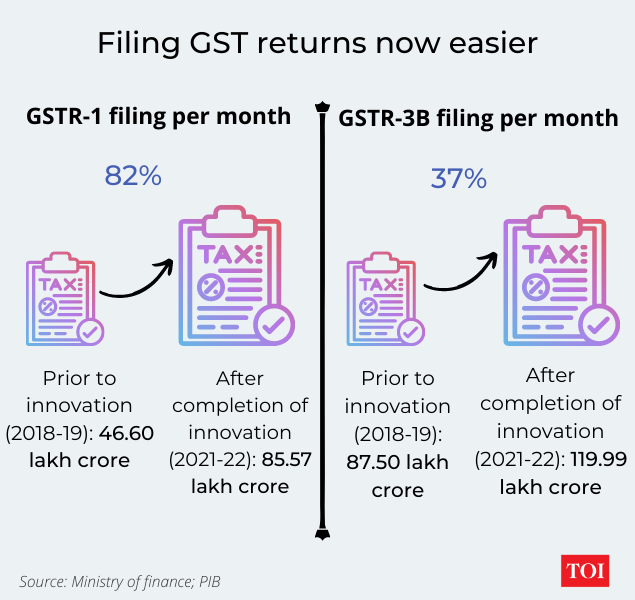
The Centre-state relationship
Under this regime, both Centre and states come together in the GST Council to thrash out modalities for smooth functioning.
When GST was rolled out, states were promised a compensation, from the cess fund, for five years if their GST collection falls short of the 14 per cent compounded revenue growth. This shortfall was to be funded through additional taxation (compensation cess) on sin/luxury goods.
However, the slowdown in economic activities that set in as a result of Covid-19 pandemic led to a shortfall in cess collection in FY20, and this increased further in FY21.
In October 2020, the government borrowed Rs 1.10 lakh crore from the market in lieu of compensation cess for shortfall in their revenue in FY21.
Apart from Rs 1.10 lakh crore compensation, the Centre had also provided Rs 0.91 lakh crore to states out of the GST compensation fund in FY21.
The states now want the government to pay GST compensation for an additional five years (post June 2022).
A recent report by SBI Research stated that for some states GST compensation as percentage of state’s tax revenue is more than 20 per cent. However, many of them are offering freebies like farm loan waiver, restoring old pension system, etc, which are economically unsustainable given the financially bad shape of many states.
“Clearly, states seem to be currently living beyond their means and it is imperative that states rationalize their spending priorities in accordance with revenue receipts,” the report added.
Where it stands today
Under GST, a four-rate structure that exempts or imposes a low rate of tax of 5 per cent on essential items and top rate of 28 per cent on cars is levied. The other slabs of tax are 12 and 18 per cent.
In the pre-GST era, the total of VAT, excise, CST and their cascading effect led to 31 per cent as tax payable, on an average, for a consumer.
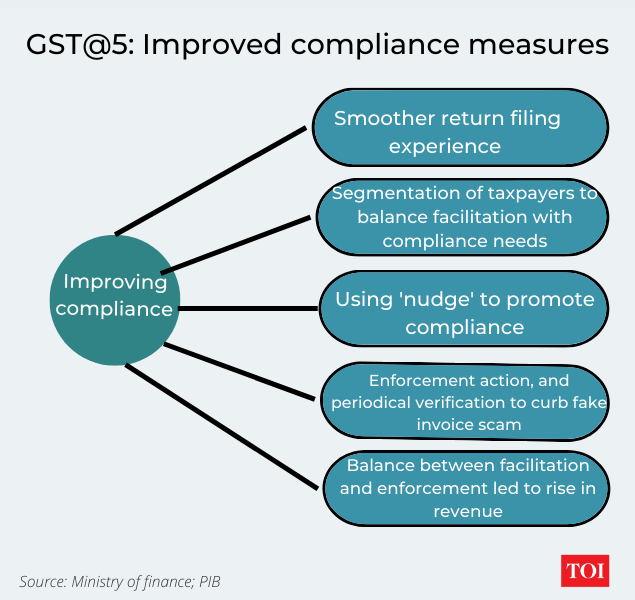
Besides, there is a special 3 per cent rate for gold, jewellery and precious stones and 1.5 per cent on cut and polished diamonds.
A cess is also levied on the highest tax slab of 28 per cent on luxury, sin and demerit goods. The collection from the cess goes to a separate corpus — Compensation fund — which is used to make up for revenue loss suffered by the state due to GST rollout.
The GST council also decided to ease the process for intra-state supplies made through e-commerce portals. Now such suppliers will not have to obtain GST registration, if their turnover is lower than Rs 40 lakh and Rs 20 lakh for goods and services, respectively. This would come into effect from January 1, 2023.
The council has also decided to constitute a group of ministers to address various concerns raised by the states in relation to constitution of the GST Appellate Tribunal and make recommendations for appropriate amendments in CGST Act.
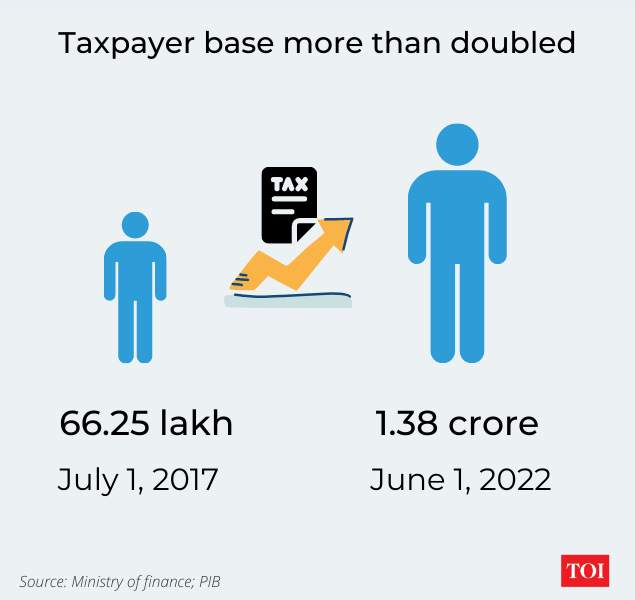
Impact on GDP
The recent surge in GST collections is said to be a good sign of economic recovery as well as of the country’s tax performance.
However, if we look at India’s gross domestic product (GDP), the comparison shows that rise in GST collections are not that significant.
In fact, India’s annual GDP was rising at a steady pace until FY2017, when it was at 8.26 per cent. From that year onwards, economic growth started to fall.
It is to be noted here that fall in GDP was not only due to implementation of GST, but also caused by yet another surprise move by the Centre, called demonetisation in 2016. As a result, with 2 back-to-back reforms announced with the GDP growth fell to as low as 3.74 per cent by FY20.
The next 2 years were marred by the Covid pandemic. GST collections were at their record low and so was India’s GDP. However, with gradual resumption of economic activities, the pace of growth gained stream and now India is poised to emerge as the fastest growing major economy.
What’s costlier, what’s cheaper
In the recently concluded GST Council meet, headed by finance minister Nirmala Sitharaman and attended by state finance ministers as members, it was decided to end exemptions and correct the inverted duty structure for several items. The tax rate changes will come into effect from July 18.
In other words, rate rationalisation request by a group of certain states was approved, resulting in tax changes, the same request by another panel of state FMs was extended by another 3 months.
Pre-packed and labelled wheat flour, papad, paneer, curd and buttermilk will be taxed at 5 per cent.
The ending of exemption would mean pre-packed and labelled meat (except frozen), fish, paneer, lassi, honey, dried leguminous vegetables, dried makhana, wheat and other cereals and puffed rice (muri) will now attract a 5 per cent tax.
Similarly, an 18 per cent GST will be levied on Tetra Packs and fees charged by banks for the issue of cheques (loose or in book form). Maps and charts including atlases will attract a 12 per cent levy. Goods that are unpacked, unlabelled and unbranded will continue to remain exempt from GST.
Besides, a 12 per cent tax will be levied on hotel rooms costing less than Rs 1,000 a day. At present, this falls under the exempted category.
A 5 per cent GST will be levied on hospital room rent above Rs 5,000 per day (excluding ICU).
Tax rates have been raised to 18 per cent on products such as printing, writing or drawing ink; knives with cutting blades, paper knives and pencil sharpeners; LED lamps, drawing and marking out instruments.
Solar water heater will now attract 12 per cent GST as compared to 5 per cent earlier.
Some services such as work contracts for roads, bridges, railways, metro, effluent treatment plants and crematoriums too will see tax going up to 18 per cent from the current 12 per cent.
Tax has, however, been cut on the transport of goods and passengers by ropeways to 5 per cent and on ostomy appliances to 5 per cent from 12 per cent.
Renting of truck, goods carriage where the cost of fuel is included will now attract a lower 12 per cent rate as against 18 per cent.